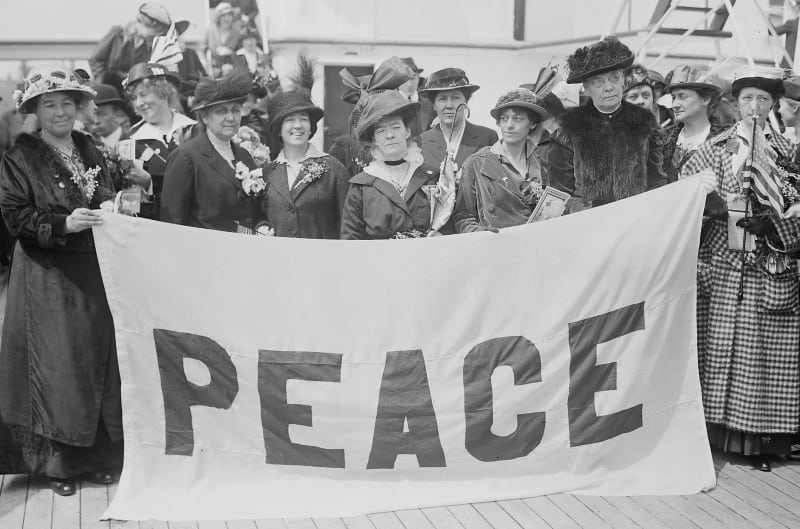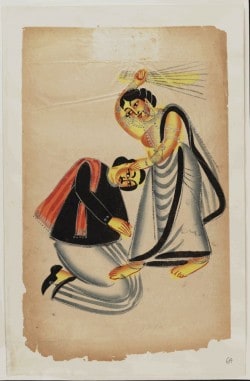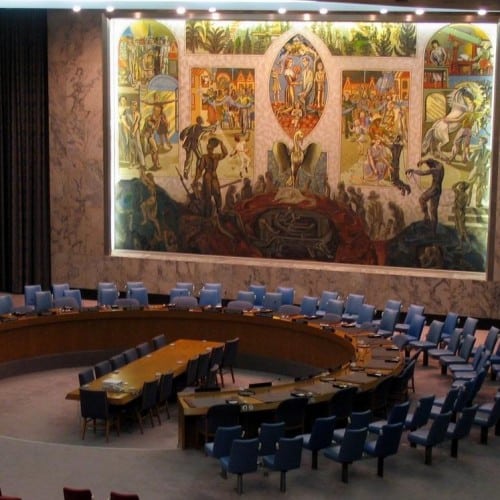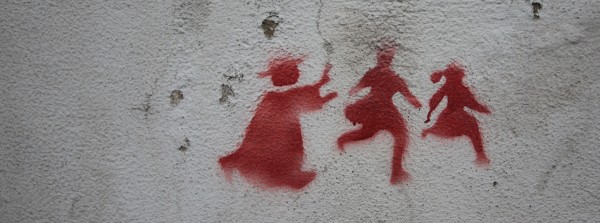This Autumn marks the 15th anniversary of the passing of UN Security Council Resolution (UNSCR 1325) 1325 on “Women, Peace and Security”. The adoption of this resolution on 31 October 2000 marked the first time that the UN Security Council dealt specifically with gender issues and women’s experiences in ‘conflict’ and ‘post-conflict’ situations and their contribution to conflict resolution and prevention. It built on existing international human rights and humanitarian law and previous UN resolutions and declarations[1] and was the culmination of almost two decades of work by women’s organisations in the global North and South concerned with gender, development and conflict.[2]
Previous UN resolutions had treated women solely as victims of war, in need of protection; but UNSCR 1325 also recognized women as agents in building peace and guaranteeing security. It is rooted in the premise that women’s inclusion—their presence and participation in the political process, their perspectives, and their contributions to the substance of negotiations —will improve the chances of attaining viable and sustainable peace.[3]
It firstly recognizes women’s contribution to peacebuilding and conflict resolution and calls for their increased participation at all decision-making levels in national, regional and international conflict prevention and resolution initiatives. Secondly, it highlights the gendered causes, dynamics and consequences of war and armed conflict and calls for the protection of women’s rights, including preventing gender-based violence against women and girls and other violations of international law. Thirdly, it calls upon local actors, member states, but also the UN system itself, to adopt a gender perspective in peace operations, negotiations and agreements. Since the passage of UNSCR 1325, subsequent Security Council Resolutions have been passed on ‘Women, Peace and Security’ including UNSCRs 1820 (2008), 1888 (2009), 1889 (2009) and 1960 (2010).
The 15th anniversary of the passing of UNSCR 1325 is a good opportunity to reflect on what has been achieved, what lessons we can learn and how we can be more effective in securing concrete changes on the ground to prevent violence, protect human rights and make progress on gender equality. Drawing on various reports, research and my own practical experience of working on these issues in Africa, New York and elsewhere over the past 18 years, I reflect here on the achievements and limitations of the ‘Women, Peace and Security’ agenda over the last 15 years.

Firstly, in terms of achievement, the majority of women’s rights organisations and activists agree that UNSCR 1325 has been highly significant for women’s peace activism. The Resolution built on a significant body of feminist research that highlights men and women’s different experiences before, during and after conflict and recognises the historical role played by women’s groups and women in mobilizing against war and in rebuilding peaceful relations in their communities after conflict.[4] The resolution has also increased awareness among international actors about women’s and gender issues in situations of armed conflict[5] and over time, a positive shift has taken place in the language of the Security Council from a primary focus on women’s victimhood to more plural understandings of women’s roles and experiences of conflict.[6]
Secondly, the ‘Women, Peace and Security’ agenda has also opened new spaces for dialogue and partnerships and provided an instrument and framework for women activists to use to mobilise locally, regionally and globally in pursuit of women’s needs and priorities in contexts affected by conflict. For example, in Colombia, Liberia and Israel, women’s activists used UNSCR 1325 to push for ground breaking new legislation[7] – although it is important to note that in other countries, women’s activism has met with more variable levels of success.[8]
At the time of writing, UNSCR 1325 has been translated into more than 100 languages and 48 National Action Plans have been drafted to assist implementation of the provisions of SCR 1325 and subsequent resolutions at the country level.[9] Furthermore, there has been some increase in funding and programming focused on the protection and participation of women in conflict situations. More recently, particular issues have received high-level attention such as preventing sexual violence in conflict with the 2013 G8 declaration on Preventing Sexual Violence in Conflict (2013) and increased funding in this area.
However, it is important to recognise that there have been a number of significant limitations and challenges, which relate to the conceptual foundations, political implications and practical implementation of SCR 1325.
 Firstly, on a conceptual level, the way that the links between gender dynamics, political transformation and conflict have often been framed in the mainstream 1325 agenda are problematic and have tended to encourage a universal approach to conflict situations that are very divergent in practice.[10] Whilst research certainly demonstrates a clear relationship between gender inequality and increased risk of intrastate conflict,[11] there is a need to look carefully at the specific ways in which gender identities are constructed and politicised and how these intersect with other structural causes of conflict in specific contexts.
Firstly, on a conceptual level, the way that the links between gender dynamics, political transformation and conflict have often been framed in the mainstream 1325 agenda are problematic and have tended to encourage a universal approach to conflict situations that are very divergent in practice.[10] Whilst research certainly demonstrates a clear relationship between gender inequality and increased risk of intrastate conflict,[11] there is a need to look carefully at the specific ways in which gender identities are constructed and politicised and how these intersect with other structural causes of conflict in specific contexts.
Furthermore, the 1325 agenda has focused almost entirely on armed conflict and is relatively silent on other forms of violence suffered by women, including structural violence, which also has implications for peace and security.
Secondly, there has been an inadequate focus on gender relations rather than just on women. The Resolution’s text and the ‘Women, Peace and Security’ agenda can be criticised for an insufficient focus on gender dynamics and the unequal relationships between men and women, which underpin the problems to be addressed. I have witnessed the practical implications of this in many countries, where it has been all too easy for men to respond that this is a ‘women’s agenda’ and use this as an excuse not to engage.
Thirdly, and similarly, there has been a lack of attention to the diverse experiences of women, for example, related to their nationality, class, ethnicity, religious, sexuality, age migration or disability status. In practice, this has sometimes meant that women are only represented or viewed through a gender lens and struggle to speak about other dimensions of the marginalisation or violence they may suffer.[12]
Fourthly, on a political level, the structures and processes put in place to implement UNSCR 1325 have largely adopted the technocratic approach of “gender mainstreaming” and have failed to challenge or transform some of the fundamental problems with the international security architecture.[13] For example, UNSCR 1325 and subsequent resolutions do not really engage with the issue of militarized masculinities and the fundamental relationships between gender and violence and gender and war proposed by critical and feminist research.[14] Indeed the implementation of UNSCR 1325 has largely been through traditional security approaches and actors such as the police and military and UN Peacekeeping Operations reinforcing the centrality of the use of force and armed personnel in working for peace and democracy.[15] There is also a significant risk that discourses on eradicating gender-based violence and empowering women can and have been instrumentalised as a pretext for foreign military intervention which has other objectives.[16]

Fourthly, and relatedly, whilst the resolution highlights the significance of women’s agency in peace and security, it tends to equate women’s agency with women’s capacity to act and fails to analyse and to address the structural factors that may constrain women’s agency.[17] For example, in practice women’s agency is constrained by particular expectations and norms about how women can articulate their priorities including in international fora on UNSCR 1325. There is a little space for a more radical agenda beyond the predominant liberal peacebuilding agenda, a factor that in turn can risk exacerbating divisions among local women’s movements and between women’s movements in different contexts.[18]
Fifthly, there are a number of clear downsides to the application of “security language” to women’s rights issues. At its heart, UNSCR 1325 contains an instrumental argument for women’s rights, emphasising the ways in which women ‘naturally’ contribute to conflict resolution and how those positive contributions can improve the Security Council’s efforts to maintain international peace and security. In other words, women’s rights are not only presented in terms of the actual security needs of women in conflict, but also in terms of what women – and gender equality – contribute to lasting peace and security. [19]This language can promote an essentialist and narrow view of women as communal ‘peacemakers’ and mothers and has the potential to reinforce the pressures on women to return to traditional, more nurturing roles in the home after violent conflict ends.

Equally, although the recent portrayal of sexual violence as a ‘weapon of war’ has brought much needed attention to the widespread sexual abuse of women in conflict, it has tended to reinforce a singular narrative about why sexual violence occurs in war, obscuring the links to sexual violence before and after the war and outside conflict zones. It has also contributed to the silencing of other forms of gender-based violence that are prevalent in conflict situations, like high levels of intimate partner violence and trafficking and sexual violence against men.[20]
Finally, research conducted by academics, civil society organization and United Nations agencies raise important questions about what impact UNSCR 1325 has actually had on the ground in terms of concrete changes in women’s lives. In spite of the increase in funding and programming in this area, most reviews accord that the implementation of UNSCR 1325 has advanced very slowly both within the UN system and at country level.[21]
For example, a multi-country review conducted in 2010 drew on women’s perspectives from six countriesand found that many governments, UN personnel and CSOs were still unaware of or misunderstood UNSCR 1325; that there was a disconnect between many donors’ policies on UNSCR 1325 and their actions, aid programmes, or diplomatic interventions in conflict affected settings; and that mediation and negotiation teams in peace processes were still failing to include women as representatives or to properly incorporate women’s perspectives. [22] It also found that, although many governments proudly claimed credit for their National Action Plans (NAPs) on UNSCR 1325, in reality most NAPs had unrealistic goals and lacked clear timelines, dedicated budgets, indicators, benchmarks and targets and clear lines of responsibility. It also found that much of the increased donor funding did not reach women activists and peacebuilders at the grassroots level.
In 2010, the UN Department of Peacekeeping Operation (DPKO) conducted a “Ten-year impact study” of implementation of UNSCR 1325.[23] It concluded that the greatest progress had been made by UN peacekeeping missions in promoting women’s participation in politics (in post-conflict elections) and in post-conflict legal and judicial reforms (e.g. gender equality provisions in new national constitutions). Some progress had been made in integrating a gender perspective into Disarmament, Demobilisation and Reintegration programmes (with some targeted programmes for women combatants) and into Security Sector Reform programming (with an increase in the proportion of uniformed female peacekeepers, although only limited progress in increasing the representation and participation of women in national security institutions). Some progress had also been made on supporting countries to adopt laws to combat Sexual and Gender-Based Violence and to protect women in conflict-situations and refugee camps through joint protection teams and patrols.
It found, however, areas of weak or no progress including ongoing low participation of women in peace negotiations and peace agreements, that most national security institutions remained hostile to women with discrimination and sexual harassment widespread, and that cases of sexual exploitation abuse by UN peacekeeping staff were on the increase again. Indeed, a 2012 UN Women review found that official peace processes remain dominated by male fighters and politicians.[24] Of 31 peace process since 1992 women averaged only 9% of members of negotiating delegations; only 4% of signatories to peace accords were women and not a since UN chief negotiator was a woman. The review concluded that there has been little appreciable increase in these figures since the passage of SCR 1325 in 2000.
In spite of these considerable challenges and limitations, in my own research and consultancy work, I have come across hundreds of dedicated women and men working on gender, violence and conflict issues across the globe and several examples of policy, advocacy and programme initiatives that are having a real impact.
Based on my own experience, I propose the following recommendations on how to make further progress with implementing UNSCR 1325 in order to realise the rights and improve the wellbeing of women and men living in violent contexts:
- Ensure detailed, specific analysis of the different types and meanings of violence in each context, how they are gendered and how they are interconnected.
- Ensure thorough political analysis of the different actors and institutions involved at local, national and regional, their interests and power relations.
- Move towards the language of ‘gender, peace and security’ to avoid the impression that this agenda is only about women and address the gender relations and dynamics that underpin violence.
- Avoid simplistic binaries and recognise that individual women and men and groups may be affected by specific forms of violence and exclusion due to the intersection of various identities (gender, race, socio-economic status etc).
- Address the normalisation and institutionalisation of violence in societies – seek to understand the specific predominant social norms and institutions that maintain the status quo, how and why.
- Engage with a wider range of political actors on the ground including local authorities, traditional and religious leaders, and rebel groups to gain their commitment to implementing this agenda.
- Keep pushing for the strengthening of implementation and accountability mechanisms around UNSCR 1325, but without taking an overly bureaucratic approach.
References:
[1]Including the Declaration of the Elimination of Violence Against Women (1993); the Beijing Declaration and Platform for Action (1995); and the Windhoek Declaration and Namibia Plan of Action (2000).
[2]Pratt, N & Richter-Devroe, S. (2011) “Critically Examining UNSCR 1325 on Women, Peace and Security” International Feminist Journal of Politics, 13:4, 489-503.
[3] Anderlini, S.N and J. Tirman (2010) “What the Women Say : Participation and UNSCR 1325 : A Case Study Assessment.” International Civil Society Action Network and the MIT Center for International Studies.
[4]See for example, Cockburn (1998) ‘The Space Between Us. Negotiating Gender and National Identities in Conflict’. London: Zed Books; Sorensen, B. (1998). Women and Post-Conflict Reconstruction: Issues and Sources. War-torn Societies Project. Geneva: UNRISD; Enloe, C, (2000) Bananas, Beaches and Bases: Making Feminist Sense of International Politics. Berkeley: University of California Press
[5]Hudson, N.F. (2013) “UNSCR 1325: the challenges of framing women’s rights as a security matter.” Norwegian Peacebuildng Resource Centre. March 2013.
[6] Shepherd, L.J. (2011) Sex, Security and Superhero(in)es: From 1325 to 1820 and Beyond International Feminist Journal of Politics, 13:4 pp504-521
[7]Anderlini and Tirman (2010) opcit.
[8]See for example, Pratt, N. (2011) “Iraqi Women and UNSCR 1325: An Interview with Sundus Abbas, Director of the Iraqi Women’s Leadership Institute, Baghdad, January 2011” International Feminist Journal of Politics, 13:4 pp 612-615; Farr, V, (2011) “UNSCR 1325 and Women’s Peace Activism in the Occupied Palestinian Territory.” International Feminist Journal of Politics, 13:4, pp 539-556
[9]See http://www.peacewomen.org/member-states
[10]Shepherd (2008) and Cohn (2008)
[11]See for example, Caprioli, M. (2005) “Primed for Violence: The Role of Gender Inequality in Predicting Internal Conflict” in International Studies Quarterly 49(2) pp 161-178
[12]Gibbings (2001) “No Angry Women at the United Nations: Political Dreams and the Cultural Politics of United Nations Security Council Resolution 1325” inInternational Feminist Journal of Politics, 13(4) pp 522-538
[13]Harrington, C. (2011) “Resolution 1325 and Post-Cold War Feminist Politics” in International Feminist Journal of Politics, 13:4, pages 557-575
[14]Gibbings (2011) opcit.
[15]See Hudson, N.F. (2013) “UNSCR 1325: the challenges of framing women’s rights as a security matter.” Norwegian Peacebuildng Resource Centre. March 2013.
[16]Harrington (2011) opcit.
[17]Shepherd (2011) opcit.
[18]Gibbings (2011) opcit.
[19]Hudson (2013) opcit.
[20]Aroussi, S. (2011) “‘Women, Peace and Security’: Addressing Accountability for Wartime Sexual Violence” in International Feminist Journal of Politics, 13(4) pp576-593
[21]See, for example, GNWP (2012) Women Count 2012 – Security Council Resolution 1325: Civil Society Monitoring Report.
[22]Anderlini and Tirman (2010) ocit.
[23] UN DPKO (2010) Ten-year Impact Study on Implementation of UN Security Council Resolution 1325 (2000) on Women, Peace and Security in Peacekeeping
[24] UN Women (2012) Women’s Participation in Peace Negotiations: Connections between Presence and Influence.






